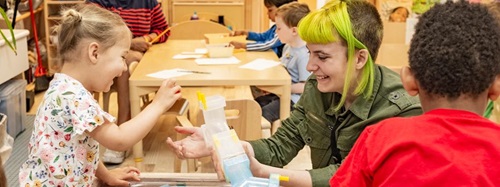Inclusion: Finding a Common Understanding
| January 2015What is High Quality Early Childhood Inclusion?
Finding a shared definition of early childhood inclusion has not always been an easy task for those of us in the field of early care and education. I remember quite well walking into my first teaching experience, a classroom full of toddlers, all of which had unique abilities and needs. I asked myself, “Is this inclusion?”
When I was a beginning teacher, simply having children with disabilities enrolled in my class made it an “inclusive” class. I quickly learned that getting each child engaged in daily routines and activities took intentional preparation and planning. Getting extra planning time, additional training, access to adaptive materials, or the right support staff was not always easy, and sometimes felt impossible. I learned quickly in that first teaching experience that a high quality environment did not always equate to a high quality inclusive experience for each child in my care.
Later when I worked as an early intervention provider I found that inclusion was defined within many different contexts, such as whether a child had certain skills, or based on the accessibility of programs identified as “inclusive,” or even based solely on the request of families. Rather than inclusion being the starting point for every child, it was often something to work towards. Fortunately, I am starting to see this change, although inclusive opportunities are far from a reality for every child.
In 2009 the National Association for the Education of Young Children (NAEYC) and the Division for Early Childhood (DEC) released a joint position statement on early childhood inclusion. The position statement defined early childhood inclusion, and provided the defining features of high quality early childhood inclusion: access, participation, and supports. For the first time we had a shared definition of early childhood inclusion:
Early childhood inclusion embodies the values, policies, and practices that support the right of every infant and young child and his or her family, regardless of ability, to participate in a broad range of activities and contexts as full members of families, communities, and society. The desired results of inclusive experiences for children with and without disabilities and their families include a sense of belonging and membership, positive social relationships and friendships, and development and learning to reach their full potential. (NAEYC/DEC, 2009)
The Defining Features
Access
Program readiness is becoming the starting point for inclusion rather than child readiness, but access to inclusive early care and education means more than getting in the front door. Access also extends to the materials in the classroom and the learning activities provided in the classroom setting. Providing access to inclusive settings can often be done by implementing simple changes, or adaptations. For example, many enrollment policies can unintentionally exclude children with diverse needs and abilities, such as a requirements on independent toileting at a certain age. Consider changes you can make to policies, the environment, and the curriculum to include any child in your care
Participation
In a recent tour of early care and education programs in my own state, I found that many programs had enrolled children with varying abilities, including children with disabilities. The early childhood educators responsible for caring for and teaching these diverse groups of children shared that they found it difficult to support many children’s active participation in the classroom. Knowledge of and use of a range of evidence-based teaching practices is absolutely fundamental to high quality inclusive environments for specific children. Some of these practices include embedded interventions, scaffolding, and tiered models of instruction. For additional information on these practices please review Research Synthesis Points on Quality Inclusive Practices
Supports
Collaboration has been referred to as a “cornerstone” of high quality inclusion (NAEYC/DEC, 2009). Collaborative partnerships among families, early childhood educators, specialists, and administrators along with systems-level supports are necessary for high quality early childhood inclusion. In addition, early care and education professionals must have access to professional development opportunities that support a clearer understanding of early childhood inclusive practices, along with the necessary supports to implement effective inclusive practices for children with varying abilities.
Envisioning an Inclusive Future for Every Child
As I explored and refined how to put the defining features of quality early childhood inclusion into practice, my later teaching experiences included many inclusion success stories. I no longer found myself questioning, what is early childhood inclusion? As an early intervention specialist I learned that the first steps to be taken were to build collaborative partnerships for inclusion. I worked together with early care and education professionals so we could plan for individual children’s access to their classroom.
We worked as a team to break down any potential barriers to enrollment, the classroom enviornment, classroom materials, and the daily routines and activities.
We intentionally supported each child’s development and learning using a range of instructional and intervention approaches, considering how each child in the class had a way to actively participate.
We sought additional training and supports when we discovered gaps in our knowledge, and we advocated for the children and families we worked with. We requested support from our program administrators and other state agencies, and shared the benefits of these inclusive opportunities with all who would listen.
As early childhood professionals we are the starting point for inclusion. We have the ability to make inclusion a reality for every child and family. We still have work ahead of us to support policies, resources, and even perceptions about inclusion, but we have a clearer vision today of an inclusive future. Together we can recognize the right of every child to have a sense of belonging and membership, positive social relationships and friendships, and development and learning to reach their full potential.
References
DEC/NAEYC. (2009). Early childhood inclusion: A joint position statement of the Division for Childhood (DEC) and the National Association for the Education of Young Children (NAEYC).Chapel Hill: The University of North Carolina, FPG Child Development Institute.
National Professional Development Center on Inclusion. (2009). Research synthesis points on early childhood inclusion. Chapel Hill: The University of North Carolina, FPG Child Development Institute, Author. Available at http://npdci.fpg.unc.edu
National Professional Development Center on Inclusion. (2011). Research synthesis points on practices that support inclusion. Chapel Hill: The University of North Carolina, FPG Child Development Institute, Author. Available at http://npdci.fpg.unc.edu
Odom, S., Buysse, V. & Soukakou, E. (2011). Inclusion for young children with disabilities: A quarter century of research perspectives. Journal of Early Intervention. 33(4), 344-356. doi:10.1177/1053815111430094







